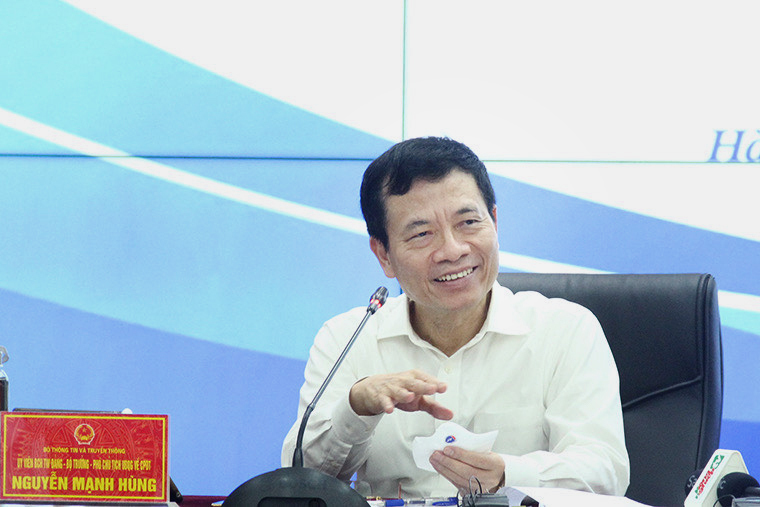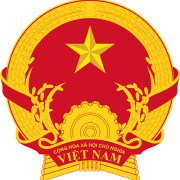
Minister of Information and Communication Nguyen Manh Hung
With digital transformation, those who have lagged behind can speed up to surpass others, so digital transformation can help change the positions and ranks. And those who proceed first will have many opportunities.
In digital transformation, the places and works where there are the biggest and longstanding difficulties, will be the easiest to succeed and see the biggest effects. It wi be easier to deal with big things than small things, and easier to solve difficult things than easy things.
The obstacles to one organization’s digital transformation lie in the heads of the organizations, not in employees, because employees and the subjects the organizations serve benefit from digital transformation.
The difficulty of farmers is that they cannot sell products directly to consumers, and because of that the price of agricultural products is already low, but the farmer's income is even lower.
The difficulty of farmers is that the bananas in their gardens they sell are just like the bananas from anywhere, i.e. the bananas with no origin and no brand, and so the selling prices are low.
The difficulty of farmers is that while they are poor, they are not sure if they can buy livestock breeders and fertilizer at the right price and quality.
The difficulty of farmers is that the prices of bananas cannot go up, because bananas are just bananas, while other products see the prices increasing because the products improve in quality all the time.
An e-commerce website can help solve these difficulties. However, the marketplace needs to connect all farmers and all consumers. Farmers put their products on sale on websites, but the products need to have specific brands and clear origins. The value of bananas includes the sun, wind and soil in the localities, value of banana varieties, and the cultivation method of each household.
So, each banana of each tree and each farmer has its speciality, its own life and original value. Therefore, the prices of the bananas are not the same.
The marketplace also connects farmers with breeders and fertilizer suppliers. It commits to provide genuine products at the right quality and at competitive prices. Technologies and digital technology firms are ready to design such a marketplace for farmers. The country’s postal companies have infrastructure and technologies capable of bringing farm produce to every household nationwide. The household in remote places can also get deliveries within two days, so farm produce is still fresh when reaching consumers.
Postmart (https://postmart.vn/) and Voso (https://voso.vn/) , two marketplaces, have connected millions of households this litchi season and hundreds of thousands of households bought fresh litchis.
Many people in Ca Mau and Da Lat had never eaten Bac Giang’s litchis, because they did not think they could get fresh litchis. But things are different this year. More than 25 million households in Vietnam, no matter where they live, all can buy litchis and receive fresh lichis after 48 hours at the latest.
It is expected that over 8,000 tons of litchis will be consumed via marketplaces and delivered into their own hands. Around 8,000 tons are just 4-5 percent of litchi output. However, the figure is still encouraging if noting that it was nearly impossible before. Such a good start has created confidence in the development of marketplaces, which help farmers distribute farm produce, not only litchis, but other hundreds or thousands of other produce. The number of millions of households buying/selling via the marketplaces is expected to increase to tens of millions by this end of the year.
Another difficulty of farmers is that they don’t have mobile waveband and don’t have devices to access the internet. But each household needs to have at least one smartphone and one fiber optic internet line.
There are 2,000 hamlets, or 2 percent of total hamlets, in Vietnam, which still don’t have mobile wave. The Ministry of Information and Communications (MIC) has instructed telecom carriers to fulfill the mobile wave coverage this year, or by June 2022 at the latest.
MIC is also running a program under which each farmer household will have at least one smartphone to access the internet by year end. The ministry is taking measures to speed up the implementation of one fiber optic internet line to every household by 2025 instead of 2030 as previously planned. And if the Ministry of Agriculture and Rural Development (MARD) joins us, the goal can be attainable by 2023.
If Vietnam can do these things, its telecommunication infrastructure in rural areas will be among the best in the world.
This is the first condition that Vietnam needs to have to carry out digital transformation.
A difficulty that always exists is the farmers’ lack of information, knowledge and training. The plan on agriculture restructuring in 2021-2025, which was signed on February 25, 2021, only sets a modest goal that the number of trained workers in the agriculture sector will account for more than 55 percent.
However, this is an old approach. What if the workers receive online training, if there is an online training platform like MOOC (massive open online course) specifically designed for farmers? What if there is a digital university for farmers, so that they don’t have to travel far to cities to study? What if farmers have chatbots with whom they can ask anything related to agriculture, rural development and farmers? What if their children or grandchildren at secondary school are taught to access the internet to help their parents and grandparents access marketplaces, train online and seek information?
If so, will 100 percent of agricultural workers be trained by 2025?
The farmers’ difficulty that always exists is the difference between the city and rural areas. Their problem is that they cannot access high-quality training for their children and high-quality healthcare services.
Narrowing the gap is a great work which can be done by digital technology and digital transformation. Online training means that the best teachers in the country can access all students, no matter whether they are in cities or rural areas.
Meanwhile, remote consultancy and health examination platforms also help farmers access the best doctors nationwide.
The teleconferencing system helps connect district hospitals with hospitals at higher levels and central hospitals, which allows doctors to receive consultancy from leading experts. This improves healthcare service quality for farmers.
Software programs using artificial intelligence (AI) technology helps doctors read X-ray images, thus narrowing the gap between rural and urban areas.
The digital technology platforms are basically ready for use. The remaining problem is popularizing them. Does the Ministry of Agriculture and Rural Development (MARD) consider popularization as one of its tasks? I think no one woud be better than the ministry in popularizing digital technologies to improve the lives of farmers. The Ministry of Information and Communications ( MIC) will go together with MARD on this path.
Farmers have problems once the husband or both husband and wife are far away at work and leave their children with their grandparents. Is there any way for parents to still be able to take care of their children from a distance? Is there any method to restrict the time of children playing games? Is there any way to tell children to use computers to study but not access ‘black websites’? Is there any way for teachers to send information about children’s learning records to the parents who are far away?
Digital technology can solve problems of this kind. So, will MARD take the lead in developing a set of tools and an ecosystem which allows farmers to teach their children though they are far away? MIC can affirm that this is within reach.
Farmers’ problems also lie in the fact that farm produce prices cannot go up, while the prices of other products, especially technology based ones, escalate all the time. How many bananas and kilograms of rice do farmers need to sell to buy an iPhone?
I am referring to bananas with no brand and no origin. But Japanese can do this.
Many farmers grow melons, persimmons and peaches, but the prices of their products vary dozens of times, depending on which province, which garden and which land the products are grown on. The development of brands for each banana, each village, each garden and each household is feasible with Blockchain technology.
There are many more things that can be done for farmers based on technology, an innovation mindset and change of thinking. Only when each banana has origin and the entire process of creating it is recorded will the people’s life change basically.
Another problem of farmers is that the cultivation process depends heavily on weather conditions. This is a thousands-of-years worry. So, is there an insurance service for this?
Kenya is doing as follows. They set up a number of automatic weather station using technology and Big Data to forecast weather and then establish an insurance fund for people. Farmers can sign up for insurance policies so that their damages due to crop failure can be partially compensated.
So, should we do a similar thing to help ease the farmers’ ‘thousands-of-years worry’ – weather conditions and natural disasters. The things that others can do can also be done by us. The problem is just whether we want to do it.
Today, MIC is introducing a list of apps for digital transformation in agriculture that have been applied successfully in other countries, and some apps that Vietnam has initially applied successfully.
Digital transformation is a process of learning. This is effective - seeing what other countries have done and doing the same things in Vietnam.
In a world that is fast changing, complex and unpredictable, no one will dare to claim to be the best. But the person who knows who is best and at what is best will be the best. That's the learner.
The best learners are those who both know and don't know. That is, people who know but are willing to recognize what they don't know. The Ministry of Agriculture and Rural Development and Ministry of Information and Communications will work together as a pair that both know and do not know to become excellent in digital transformation in agriculture, rural areas and farmers.
I am very grateful to Minister of Agriculture and Rural Development Le Minh Hoan for today's meeting. In digital transformation, application is more important than technology. The people applying these are more important than technology makers. There will be no technology if there is no pioneer in technology application.
For digital technology, the more that technology is applied, the smarter, the cheaper it will be, with more users.
So, the high number of users will make digital technology smarter and cheaper. With 60-70 percent of Vietnam's population farmers, they will determine the success of Vietnam's digital transformation.
